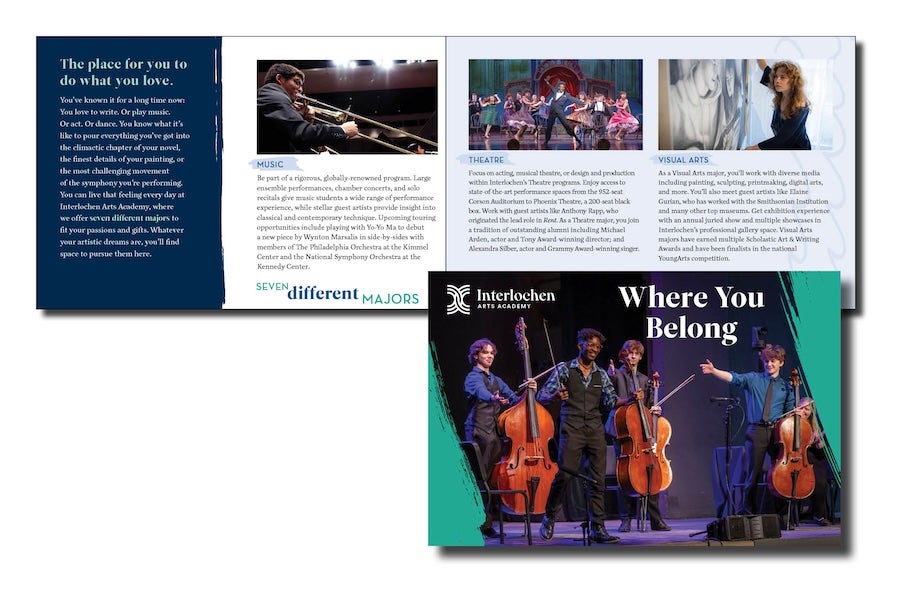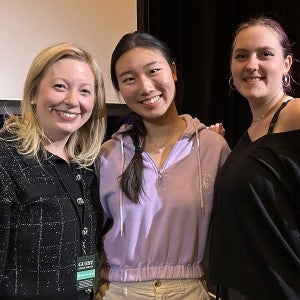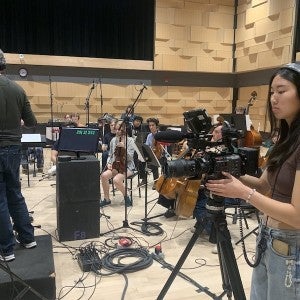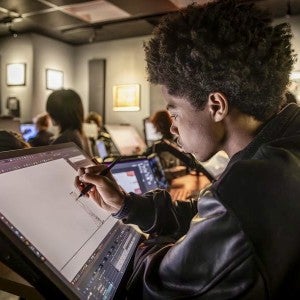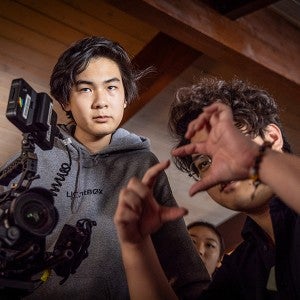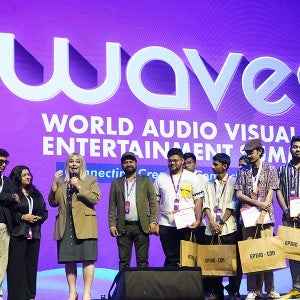A day in the life at one of the best filmmaking high schools in the United States
Get a behind-the-scenes look at Interlochen Arts Academy’s Film & New Media major—from arts-focused academic classes to collaborations with other artistic disciplines.

If you’ve ever read through a movie’s cast and crew list on IMDB, you know how many hands it takes to create a film that excites and inspires.
From lead actors and extras to gaffers and sound mixers, a vast team of creatives—each with their own unique skills—works both in front of and behind the camera to bring the director’s vision to life. Assembling this team of collaborators is a daunting task for a Hollywood production company; it’s even more challenging for a budding high school filmmaker with just an iPhone and a dream.
If you’re committed to pursuing your passion for film, an arts high school is an ideal environment to connect and collaborate with peers with talents in music, acting, visual arts, and other disciplines—all while studying with expert instructors, building your creative and technical skills, and developing a robust portfolio.
Sound too good to be true? It’s not! Each year, hundreds of young artists study film at fine arts high schools like Interlochen Arts Academy—one of the best filmmaking high schools in the United States. In this article, we’ll take you behind the scenes of Interlochen’s Film & New Media major for an inside look at life at a filmmaking high school.
Morning rituals and arts-focused academics
Depending on your schedule and personal preferences, your day will probably begin sometime between 6 and 8 a.m. Although quiet hours are enforced until 7 a.m., you’re welcome to wake up earlier to get ready for your day, hit the gym, or engage in quiet activities such as reading, journaling, or meditation.
Most Interlochen Arts Academy students choose to begin their day with breakfast at Stone Cafeteria, where conversations buzz with creative energy. Discussions range from favorite symphonies to experimental theatre techniques, creating an atmosphere where inspiration flows naturally between artistic disciplines. This interdisciplinary exposure is fundamental to the Interlochen experience—allowing you to gain perspectives that traditional high schools cannot provide.
Mornings at the Academy are typically reserved for academic classes; the daily schedule officially begins at 8:30 a.m., with an optional “Zero Hour” period at 7:30 a.m. Beyond the subjects you’ll find at your local high school, Interlochen Arts Academy offers a variety of specialized academic courses that can enhance your development as a filmmaker. Interested in making documentaries? Enroll in Contemporary Events and Journalism. Want to study history through the lens of film? Take History, Research, and Film.
You’ll also find connections to your passion in more conventional academic subjects such as physics, algebra, or French. All Arts Academy academic instructors are encouraged to infuse the arts into their lessons—a challenge that many respond to with enthusiasm. You might discover the mathematical principles behind camera angles in geometry class; explore how microphones interact with sound waves in physics class; or write a paper about Jean-Luc Godard or François Truffaut for your French class. This approach ensures that filmmaking students develop intellectual depth, creating well-rounded artists prepared for the complexities of modern media production and the rigors of college-level study.
Creative development and technical mastery
After your morning classes, you’ll take a mid-day break—which includes time to eat lunch and attend office hours with your academic faculty.
On Wednesdays, you’ll enjoy special programming that explores Interlochen’s unique social-emotional learning program, The Interlochen 5. You’ll discuss topics such as mindfulness, creative capacity, and collaboration with your advisory group—a small, faculty-led cohort of fellow students—and attend the weekly Community Meeting at 2 p.m.
Afternoons at the Academy are primarily reserved for arts activities, including major-specific classes, guest artist lectures, and time to work on creative projects.
Interlochen's Film & New Media curriculum emphasizes both technical proficiency and artistic vision. Courses such as Film History, Film Genres, and World Directors enable you to gain a global and historical perspective on the discipline while discovering your unique interests and style. You’ll also explore the principles of cinematic storytelling and character development through courses such as Introduction to Screenwriting, Film Aesthetics, and Advanced Screenwriting.
Other courses offer opportunities to gain hands-on experience with professional-grade film equipment and software. You’ll master industry-standard software such as Premiere and After Effects in Editing & Motion Graphics; practice cinematic location lighting in Lighting class; and learn the basics of camera operation, audio recording, film set etiquette, and more in Visual Story.
The film program offers opportunities to put your skills into practice by creating short films and longer-form film projects and screening them at regular student showcases. Your experience will culminate with a Capstone project—a project that challenges you to apply everything you’ve learned as you propose, research, and execute a fiction or nonfiction production, script, or new media project.
The DeRoy Center for Film Studies is the “home base” for film students at Interlochen. The only building in the nation dedicated to the study of film at the high school level, the 26,000 square-foot living-learning space features a 178-seat screening room equipped with 7.1 surround and a 4K DCP projector; a 40’ x 40’ sound stage; four editing suites; several state-of-the-art classrooms; an animation suite; and a number of student residence hall rooms that are prioritized to Film & New Media majors to allow after-class access to facilities. Students can also utilize the division’s top-of-the-line film equipment, including ARRI lighting and Blackmagic 6K Pro cameras.
Collaboration across generations and disciplines
Interdisciplinary collaboration is one of the defining characteristics of the film program at Interlochen Arts Academy. In addition to film, the Academy offers programs in six other artistic disciplines—music, theatre, visual arts, creative writing, dance, and interdisciplinary arts—enabling students to make connections with artists in other fields.
In this vibrant multidisciplinary environment, film students can easily find creative partners to help bring their vision to life. Musicians create and perform original scores for film projects; theatre majors serve as on-camera talent; and visual artists assist with set and costume design.
One noteworthy example of interdisciplinary collaboration is the original musical film How the Moon Fell from the Sky and No One Even Noticed. Written by Jack Fossett and directed by Christina Xing, the 40-minute film was created as an extracurricular project and featured an all-student cast and crew.
“It was amazing to be able to create something that would have cost thousands of dollars in the real world,” said cinematographer Shane Bagwell. “We were able to make it on a small budget because we were surrounded by artists who were willing to give their time. Visual artists helped us paint sets. The whole orchestra played for us. We had free crew members all around us. All those hands being able to come together—there’s no other situation like that.”
Film & New Media students have also collaborated with peers in the singer-songwriter program to create music videos and contributed live-action or animated films to multidisciplinary productions such as MUKTI and ONE. In 2023, the division launched the Interlochen Cinema Collective—a multigenerational group of students, faculty, alumni, and guest artists dedicated to the creation of fully realized film productions. The collective’s inaugural project, “Jedo’s Dead,” premiered at SXSW, where it was selected as the winner of the Texas Shorts Jury Award. The collective’s next project, a documentary on regenerative agriculture, is currently in progress.
Master classes with industry leaders
Beyond daily classes with world-class faculty, Film & New Media students also enjoy regular visits from industry professionals. The centerpiece of the division’s visiting artist program is the Future of Cinema Film Festival, a multi-day event that features lectures, demonstrations, Q&A sessions, and film screenings with leaders from every facet of the film industry—from directors and screenwriters to animators and composers. Recent guests include Nimona director Troy Quane; The Sandman writer Allan Heinberg; writer and producer Sev Ohanian; and author and producer Angie Thomas, among others.
Evening performances and inspiration
Once the class day concludes, Academy students are free to use their “down time” however they choose. Many students choose to spend their evening attending one of the hundreds of events staged by Academy students, faculty, and guests each year. These performances serve as both entertainment and education for filmmaking students, providing artistic experiences that inform and inspire their own creative development.
Beyond the stage, Arts Academy students may participate in a wide range of school-sponsored clubs, sports teams, and recreational activities. The school’s Recreation and Wellness team hosts regular events both on and off campus—including movie and game nights, holiday celebrations, hiking trips, dances, and more.
For film students, evenings are also the optimal time to draft scripts, work on post-production, or collaborate with peers from other divisions, who may not be available during the afternoons due to their own class schedules.
“We used to film our productions late at night, sometimes outside, in the middle of winter,” recalls Arts Academy alumnus and Five to Sixty founder Nic Weinfeld. “I remember ordering Bud’s and late-night editing sessions—and definitely not eating Bud’s inside the editing suites!”
All boarding students are required to check into their residence halls by 9:30 p.m. The day ends with ‘lights out’ at 11 p.m.
The Interlochen advantage
The immersive artistic environment at Interlochen Arts Academy cultivates filmmaking students who possess both technical expertise and broad cultural literacy. Daily interaction with serious young artists from all disciplines develops creative problem-solving skills, collaborative abilities, and artistic vision that extends far beyond conventional film education.
Every day presents opportunities to grow as an artist while building the professional skills necessary for success in an increasingly competitive industry. This unique combination of rigorous academics, technical training, cross-disciplinary collaboration, and exposure to professional mentors creates graduates uniquely prepared for the complexities of modern media production.
The day in the life of an Interlochen filmmaking student reveals an educational experience that transcends traditional boundaries, fostering young artists who understand that great cinema emerges from the intersection of technical mastery, collaborative spirit, and profound artistic vision.
Dive deeper into Interlochen Arts Academy with a free digital viewbook
